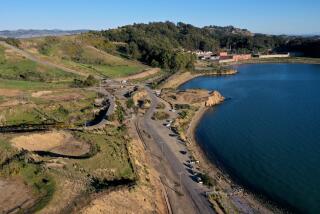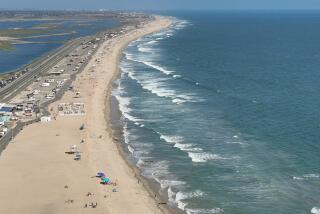End of the Line Is in Sight for El Morro Mobile Homes
State officials said this week they intend to close the landmark El Morro Mobile Home Park within four years and create a new recreation area overlooking the Pacific Ocean complete with campsites, picnic benches and parking.
The $13-million proposal, which would give the public access to 10 acres of prime oceanside and canyon land just south of Crystal Cove State Park, is expected to be unveiled next year and could break ground in 2005.
For the record:
12:00 a.m. April 20, 2001 For the Record
Los Angeles Times Friday April 20, 2001 Orange County Edition Metro Part B Page 3 Metro Desk 2 inches; 46 words Type of Material: Correction
El Morro--Articles on April 12 and April 15 incorrectly stated who sold land at the El Morro Mobile Home Park and the adjacent Crystal Cove to the state. The oceanfront property north of Laguna Beach was turned over to the state in 1979 by the Irvine Co., then run by a group of investors including Joan Irvine Smith and Donald Bren.
The state Parks and Recreation Department has owned the land since the Irvine family sold it with the rest of Crystal Cove in the 1970s. It leases portions of lots to mobile home owners.
The move comes as the state is advancing plans to renovate historic cottages nearby at Crystal Cove and is part of a larger goal to make the highly valuable land just north of Laguna Beach more accessible to the public for day trips, camping and overnight rentals.
“This is public land that needs to be opened to the public,” said Rusty Areias, executive director of the parks department. “Our plan is to . . . clear the beach in 2004 and provide for camping on the bluff.”
While there has long been talk of creating a recreation area at the site, officials said they now expect to obtain the needed funds and have made it clear to El Morro residents that there will be no lease extensions past December 2004.
But El Morro residents, some of whom have lived amid the eclectic assortment of two-stories and doublewides for decades, said they are troubled by the state’s plans and won’t leave without a fight.
Ryan and Bunny Jeffries, who own a mobile home and have been coming to El Morro for more than 40 years, lament the possibility that it could all end.
“It seems kind of a shame they want to rip it up and put a campground in,” said Ryan Jeffries, who owns an almond farm outside Bakersfield. “There’s already too many people around here. That’s progress, I guess.”
He and his wife said their best memories are the ones spent with their three children who got to grow up on the beach.
“It’s really a slice of heaven here,” said Bunny Jeffries, gazing out at a breaking surf. “It hasn’t changed. It’s just like it was when we were kids.”
Many residents said they will push to extend their leases beyond 2004, though exactly how remains unclear. State officials report that El Morro dwellers are now seeking a lobbyist in Sacramento who can press their case.
The first mobile homes arrived at El Morro in the 1940s, when the Irvine family began leasing land around the pristine cove.
Over time, the mobile home park became a familiar sight to travelers making their way between Laguna Beach and Newport Beach. It is known for its mixture of residents, from senior citizens living on Social Security to wealthy attorneys, doctors and business executives who use El Morro as a weekend getaway.
There are about 295 mobile homes extending from the beach up a hill above Pacific Coast Highway. Most residents live there only on weekends or in the summer, but there are some year-round residents as well.
The state has been negotiating with residents of the Crystal Cove cottages over how best to refurbish the historic structures. The cottages are on the National Register of Historic Places as the last intact example of a 1920s Southern California beach colony. But they are showing their age, giving way to the salty sea air, and need to be refurbished.
The state originally planned to evict the residents and lease the cottages to a developer who would remake the buildings into a luxury resort. But after a public outcry, the state bought out the development contract and will restore the cottages on its own. The residents, however, must leave by July.
State officials said El Morro residents knew when they signed leases in 1999 that there was no guarantee that they would be allowed to stay past 2004. The leases generate about $1 million a year for the state, but Roy Stearns, spokesman for the state parks department, said the income is not as important as allowing the general public to enjoy it.
“The bottom line is to open it up to public access, and that will happen,” he said.
The recreation area was conceived in the early 1980s as part of a master plan for the Crystal Cove area. By next year, detailed plans for the campsite, parking lot and beach picnic grounds will be completed, officials said.
If the plan is approved and the mobile homes are removed, work would begin on returning the area to its natural state, including removing the concrete channels along El Moro Creek to make it a scenic waterway that flows freely to the ocean.
The state also intends to remove the paved roads as well as all the septic tanks used by the mobile homes.
“This is a state park, and I don’t think state parks should be in the business of being landlords,” Stearns said. “It’s not private lands.”
Still, some El Morro residents hold out hope that they will be able somehow to stay where they are.
If not, said resident John Balfanz of Bakersfield, “I think we’re going to have a whole heck of a lot of unhappy people.”
More to Read
Sign up for Essential California
The most important California stories and recommendations in your inbox every morning.
You may occasionally receive promotional content from the Los Angeles Times.










